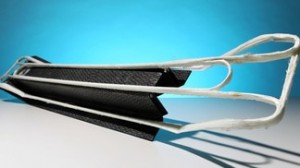 The use of composite materials is rapidly entering into the automotive industry thanks to a technique developed by the EPFL spin-off EELCEE. This technique promises lighter cars that burn less fuel and, consequently, emit less CO2.
The use of composite materials is rapidly entering into the automotive industry thanks to a technique developed by the EPFL spin-off EELCEE. This technique promises lighter cars that burn less fuel and, consequently, emit less CO2.
In 2013, we may see car bumpers, doors, and frames made from composite materials, which are engineered or naturally occurring materials such as fiberglass made from two or more constituents with different physical or chemical properties. Since new composites are more durable and yet still lighter than their metal counterparts, they make for lighter cars that consume less gas and release less CO2.
Ready For Mass Production
Until now, composites laid down in fiber and resin have been reserved for aeronautics, sailing, or Formula 1 racing because of the complexity of their production. But the auto-industry has long been interested in getting these materials into mass production. The problem has been the time required to make these components. Now, EELCEE, an EPFL spin-off company, has developed a process that allows for the fabrication of composite parts quickly and in large quantities.
The EELCEE technology, developed by Jan-Anders Månson and his team in the Laboratory of Composites and Polymers at EPFL, is based on the methods used for molding plastics: the desired material is pressure-injected into a compressed mold. For parts made from composite materials, the molds are first made, then the necessary filaments are created for carbon fiber or fiberglass materials. These are subsequently consolidated with resin and set aside to form a thin, flexible, and ultra-light framework. Finally, another layer of resin is injected into the mold.
“There are actually 36 filament textures available depending on the intended application,” explains Jan-Anders Månson. “In relation to metal, the weight savings is between 20 and 40 percent, depending on the composite pieces used.”
Rapid, Efficient Process
The pressure injection process is extremely rapid, which saves the laborious work of assembling and welding various parts. “With this method, the number of parts per year produced by an assembly line is greatly increased and could reach a million, while the costs of production are reduced by 10 percent on average,” estimates Månson.
Swedish investors have already invested 6.8 million francs in EELCEE in hopes of bringing this technology to their country’s auto industry. The EPFL spin-off, based out of the Scientific Park of Ecublens (PSE), is in contact with many suppliers of the large automotive companies and hopes to see the first cars equipped with composite fiber bumpers made using this process in 2013.
There’s no limiting this new methodology to cars. EELCEE has already tested their technology on other products as diverse as car seats and suitcases in hopes of bringing the advantages of mass-produced composite material parts to other sectors.



